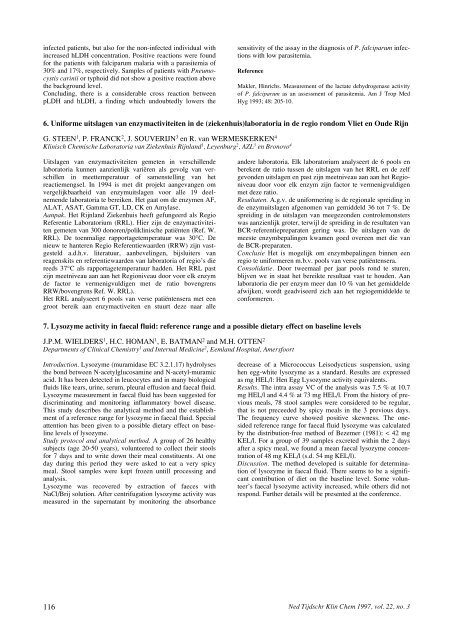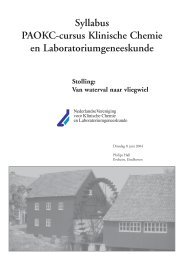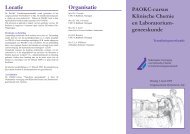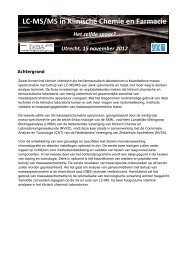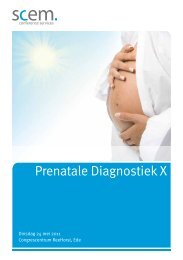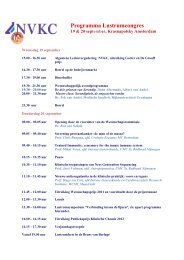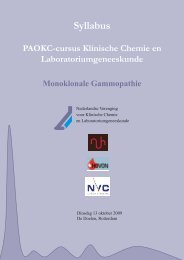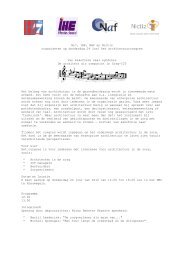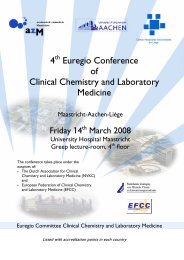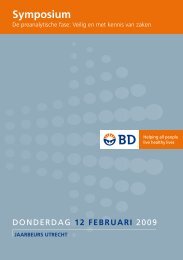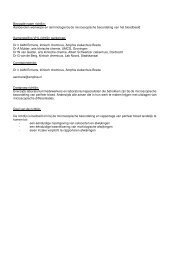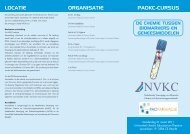Klinische (bio)chemie en methodologie - NVKC
Klinische (bio)chemie en methodologie - NVKC
Klinische (bio)chemie en methodologie - NVKC
Create successful ePaper yourself
Turn your PDF publications into a flip-book with our unique Google optimized e-Paper software.
infected pati<strong>en</strong>ts, but also for the non-infected individual with<br />
increased hLDH conc<strong>en</strong>tration. Positive reactions were found<br />
for the pati<strong>en</strong>ts with falciparum malaria with a parasitemia of<br />
30% and 17%, respectively. Samples of pati<strong>en</strong>ts with Pneumocystis<br />
carinii or typhoid did not show a positive reaction above<br />
the background level.<br />
Concluding, there is a considerable cross reaction betwe<strong>en</strong><br />
pLDH and hLDH, a finding which undoubtedly lowers the<br />
s<strong>en</strong>sitivity of the assay in the diagnosis of P. falciparum infections<br />
with low parasitemia.<br />
Refer<strong>en</strong>ce<br />
Makler, Hinrichs. Measurem<strong>en</strong>t of the lactate dehydrog<strong>en</strong>ase activity<br />
of P. falciparum as an assessm<strong>en</strong>t of parasitemia. Am J Trop Med<br />
Hyg 1993; 48: 205-10.<br />
6. Uniforme uitslag<strong>en</strong> van <strong>en</strong>zymactiviteit<strong>en</strong> in de (ziek<strong>en</strong>huis)laboratoria in de regio rondom Vliet <strong>en</strong> Oude Rijn<br />
G. STEEN 1 , P. FRANCK 2 , J. SOUVERIJN 3 <strong>en</strong> R. van WERMESKERKEN 4<br />
Klinisch Chemische Laboratoria van Ziek<strong>en</strong>huis Rijnland 1 , Ley<strong>en</strong>burg 2 , AZL 3 <strong>en</strong> Bronovo 4<br />
Uitslag<strong>en</strong> van <strong>en</strong>zymactiviteit<strong>en</strong> gemet<strong>en</strong> in verschill<strong>en</strong>de<br />
laboratoria kunn<strong>en</strong> aanzi<strong>en</strong>lijk variër<strong>en</strong> als gevolg van verschill<strong>en</strong><br />
in meettemperatuur of sam<strong>en</strong>stelling van het<br />
reactiem<strong>en</strong>gsel. In 1994 is met dit projekt aangevang<strong>en</strong> om<br />
vergelijkbaarheid van <strong>en</strong>zymuitslag<strong>en</strong> voor alle 19 deelnem<strong>en</strong>de<br />
laboratoria te bereik<strong>en</strong>. Het gaat om de <strong>en</strong>zym<strong>en</strong> AF,<br />
ALAT, ASAT, Gamma GT, LD, CK <strong>en</strong> Amylase.<br />
Aanpak. Het Rijnland Ziek<strong>en</strong>huis heeft gefungeerd als Regio<br />
Refer<strong>en</strong>tie Laboratorium (RRL). Hier zijn de <strong>en</strong>zymactiviteit<strong>en</strong><br />
gemet<strong>en</strong> van 300 donor<strong>en</strong>/poliklinische patiënt<strong>en</strong> (Ref. W.<br />
RRL). De to<strong>en</strong>malige rapportagetemperatuur was 30°C. De<br />
nieuw te hanter<strong>en</strong> Regio Refer<strong>en</strong>tiewaard<strong>en</strong> (RRW) zijn vastgesteld<br />
a.d.h.v. literatuur, aanbeveling<strong>en</strong>, bijsluiters van<br />
reag<strong>en</strong>skits <strong>en</strong> refer<strong>en</strong>tiewaard<strong>en</strong> van laboratoria of regio’s die<br />
reeds 37°C als rapportagetemperatuur hadd<strong>en</strong>. Het RRL past<br />
zijn meetniveau aan aan het Regioniveau door voor elk <strong>en</strong>zym<br />
de factor te verm<strong>en</strong>igvuldig<strong>en</strong> met de ratio bov<strong>en</strong>gr<strong>en</strong>s<br />
RRW/bov<strong>en</strong>gr<strong>en</strong>s Ref. W. RRL).<br />
Het RRL analyseert 6 pools van verse patiënt<strong>en</strong>sera met e<strong>en</strong><br />
groot bereik aan <strong>en</strong>zymactiveit<strong>en</strong> <strong>en</strong> stuurt deze naar alle<br />
andere laboratoria. Elk laboratorium analyseert de 6 pools <strong>en</strong><br />
berek<strong>en</strong>t de ratio tuss<strong>en</strong> de uitslag<strong>en</strong> van het RRL <strong>en</strong> de zelf<br />
gevond<strong>en</strong> uitslag<strong>en</strong> <strong>en</strong> past zijn meetniveau aan aan het Regioniveau<br />
door voor elk <strong>en</strong>zym zijn factor te verm<strong>en</strong>igvuldig<strong>en</strong><br />
met deze ratio.<br />
Resultat<strong>en</strong>. A.g.v. de uniformering is de regionale spreiding in<br />
de <strong>en</strong>zymuitslag<strong>en</strong> afg<strong>en</strong>om<strong>en</strong> van gemiddeld 36 tot 7 %. De<br />
spreiding in de uitslag<strong>en</strong> van meegezond<strong>en</strong> controlemonsters<br />
was aanzi<strong>en</strong>lijk groter, terwijl de spreiding in de resultat<strong>en</strong> van<br />
BCR-refer<strong>en</strong>tiepreparat<strong>en</strong> gering was. De uitslag<strong>en</strong> van de<br />
meeste <strong>en</strong>zymbepaling<strong>en</strong> kwam<strong>en</strong> goed overe<strong>en</strong> met die van<br />
de BCR-preparat<strong>en</strong>.<br />
Conclusie Het is mogelijk om <strong>en</strong>zymbepaling<strong>en</strong> binn<strong>en</strong> e<strong>en</strong><br />
regio te uniformer<strong>en</strong> m.b.v. pools van verse patiënt<strong>en</strong>sera.<br />
Consolidatie. Door tweemaal per jaar pools rond te stur<strong>en</strong>,<br />
blijv<strong>en</strong> we in staat het bereikte resultaat vast te houd<strong>en</strong>. Aan<br />
laboratoria die per <strong>en</strong>zym meer dan 10 % van het gemiddelde<br />
afwijk<strong>en</strong>, wordt geadviseerd zich aan het regiogemiddelde te<br />
conformer<strong>en</strong>.<br />
7. Lysozyme activity in faecal fluid: refer<strong>en</strong>ce range and a possible dietary effect on baseline levels<br />
J.P.M. WIELDERS 1 , H.C. HOMAN 1 , E. BATMAN 2 and M.H. OTTEN 2<br />
Departm<strong>en</strong>ts of Clinical Chemistry 1 and Internal Medicine 2 , Eemland Hospital, Amersfoort<br />
Introduction. Lysozyme (muramidase EC 3.2.1.17) hydrolyses<br />
the bond betwe<strong>en</strong> N-acetylglucosamine and N-acetyl-muramic<br />
acid. It has be<strong>en</strong> detected in leucocytes and in many <strong>bio</strong>logical<br />
fluids like tears, urine, serum, pleural effusion and faecal fluid.<br />
Lysozyme measurem<strong>en</strong>t in faecal fluid has be<strong>en</strong> suggested for<br />
discriminating and monitoring inflammatory bowel disease.<br />
This study describes the analytical method and the establishm<strong>en</strong>t<br />
of a refer<strong>en</strong>ce range for lysozyme in faecal fluid. Special<br />
att<strong>en</strong>tion has be<strong>en</strong> giv<strong>en</strong> to a possible dietary effect on baseline<br />
levels of lysozyme.<br />
Study protocol and analytical method. A group of 26 healthy<br />
subjects (age 20-50 years), volunteered to collect their stools<br />
for 7 days and to write down their meal constitu<strong>en</strong>ts. At one<br />
day during this period they were asked to eat a very spicy<br />
meal. Stool samples were kept froz<strong>en</strong> untill processing and<br />
analysis.<br />
Lysozyme was recovered by extraction of faeces with<br />
NaCl/Brij solution. After c<strong>en</strong>trifugation lysozyme activity was<br />
measured in the supernatant by monitoring the absorbance<br />
decrease of a Micrococcus Leisodycticus susp<strong>en</strong>sion, using<br />
h<strong>en</strong> egg-white lysozyme as a standard. Results are expressed<br />
as mg HEL/l: H<strong>en</strong> Egg Lysozyme activity equival<strong>en</strong>ts.<br />
Results. The intra assay VC of the analysis was 7.5 % at 10.7<br />
mg HEL/l and 4.4 % at 73 mg HEL/l. From the history of previous<br />
meals, 78 stool samples were considered to be regular,<br />
that is not preceeded by spicy meals in the 3 previous days.<br />
The frequ<strong>en</strong>cy curve showed positive skewness. The onesided<br />
refer<strong>en</strong>ce range for faecal fluid lysozyme was calculated<br />
by the distribution-free method of Bezemer (1981): < 42 mg<br />
KEL/l. For a group of 39 samples excreted within the 2 days<br />
after a spicy meal, we found a mean faecal lysozyme conc<strong>en</strong>tration<br />
of 48 mg KEL/l (s.d. 54 mg KEL/l).<br />
Discussion. The method developed is suitable for determination<br />
of lysozyme in faecal fluid. There seems to be a significant<br />
contribution of diet on the baseline level. Some volunteer’s<br />
faecal lysozyme activity increased, while others did not<br />
respond. Further details will be pres<strong>en</strong>ted at the confer<strong>en</strong>ce.<br />
116 Ned Tijdschr Klin Chem 1997, vol. 22, no. 3


